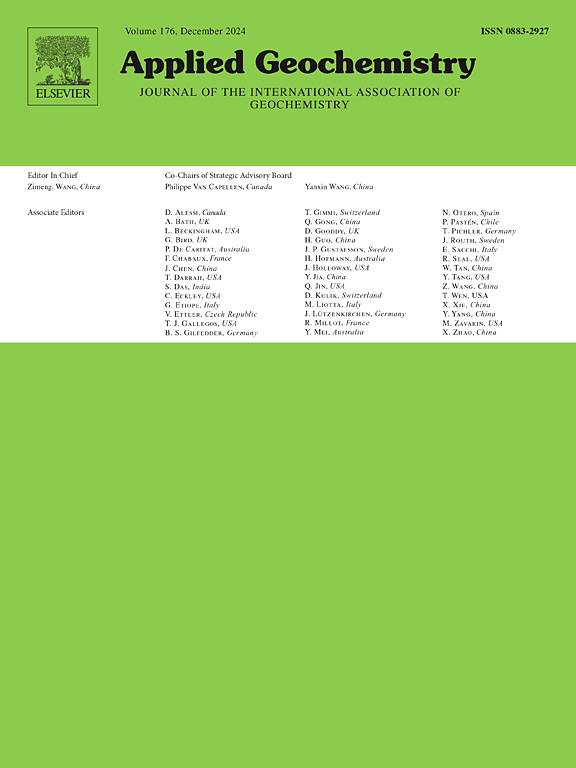白垩纪海洋红层主要元素和稀土元素地球化学:对陆相硅酸盐风化和海洋沉积环境的启示
IF 3.1
3区 地球科学
Q1 GEOCHEMISTRY & GEOPHYSICS
引用次数: 0
摘要
在白垩纪,全球海洋氧化还原状态剧烈波动,导致了黑色页岩和白垩纪海洋红床的沉积。在此基础上,研究了藏南和北大西洋沉积的晚corb组和下伏页岩中主元素计算的化学风化强度指标和稀土元素地球化学行为。尽管全球在晚白垩世整体变冷,但这两个地点的cobs原始沉积环境在相对温暖和潮湿的条件下,化学风化程度增强。后太古代澳大利亚页岩(PAAS)标准化后的Ce异常(0.65 ~ 1.46)和LREE/HREE比值(0.60 ~ 0.94)在页岩层中的较大变化是铁矿物转化的结果,PAAS标准化后的Eu异常(0.93 ~ 1.50)普遍为正,可能受物质来源控制。总REE和Fe2O3含量高于下伏页岩,且与化学风化强度呈相似的协变关系。研究认为,大量陆源铁通过陆相风化作用进入了含氧的白垩纪海洋,稀土分选是反映埃迪卡拉纪和显生宙海洋红层形成位置和相对沉积速率的潜在指标。本文章由计算机程序翻译,如有差异,请以英文原文为准。
Major and rare earth elements geochemistry of the Cretaceous ocean red beds: Implications for the terrestrial silicate weathering and marine sedimentary environment
During the Cretaceous, global ocean redox state fluctuated dramatically, resulting in the deposition of black shales and Cretaceous Ocean Red Beds (CORB). Herein, the chemical weathering intensity indexes calculated by major elements and the geochemical behaviors of rare earth elements (REE) were investigated in the late CORBs and the underlying shales deposited in southern Tibet and the Northern Atlantic. The original deposition environment of CORBs from both sites showed intensified chemical weathering extent under relatively warm and humid conditions, despite an overall global cooling trend during the late Cretaceous. The large variations of Ce anomalies (0.65–1.46) and LREE/HREE ratios (0.60–0.94) normalized by Post-Archean Australian Shale (PAAS) in the shale layers were the results of Fe mineral transformation, and the generally positive PAAS-normalized Eu anomalies (0.93–1.50) were likely controlled by the material sources. The CORBs displayed higher contents of total REE and Fe2O3 than the underlying shales, and had a similar covariant relationship with the chemical weathering intensity. This study suggested that a large amount of terrigenous iron was transported into the oxic Cretaceous Ocean by continental weathering, and REE fractionations were potential indicators to reflect sedimentary location and relatively sedimentation rate of ocean red beds formation across the Ediacaran and Phanerozoic.
求助全文
通过发布文献求助,成功后即可免费获取论文全文。
去求助
来源期刊

Applied Geochemistry
地学-地球化学与地球物理
CiteScore
6.10
自引率
8.80%
发文量
272
审稿时长
65 days
期刊介绍:
Applied Geochemistry is an international journal devoted to publication of original research papers, rapid research communications and selected review papers in geochemistry and urban geochemistry which have some practical application to an aspect of human endeavour, such as the preservation of the environment, health, waste disposal and the search for resources. Papers on applications of inorganic, organic and isotope geochemistry and geochemical processes are therefore welcome provided they meet the main criterion. Spatial and temporal monitoring case studies are only of interest to our international readership if they present new ideas of broad application.
Topics covered include: (1) Environmental geochemistry (including natural and anthropogenic aspects, and protection and remediation strategies); (2) Hydrogeochemistry (surface and groundwater); (3) Medical (urban) geochemistry; (4) The search for energy resources (in particular unconventional oil and gas or emerging metal resources); (5) Energy exploitation (in particular geothermal energy and CCS); (6) Upgrading of energy and mineral resources where there is a direct geochemical application; and (7) Waste disposal, including nuclear waste disposal.
 求助内容:
求助内容: 应助结果提醒方式:
应助结果提醒方式:


